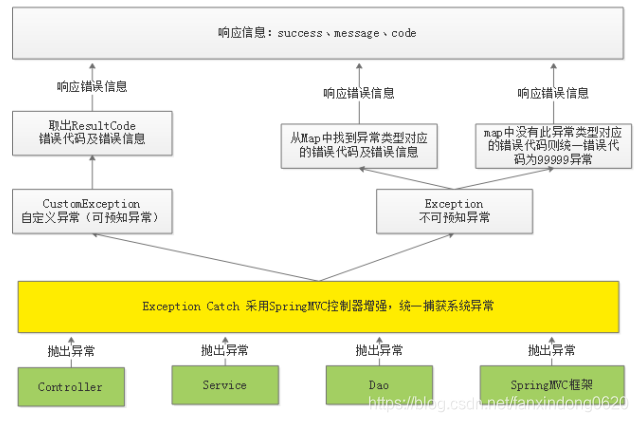文章目录
- 1.异常处理的问题分析
- 2.异常处理流程
- 3.可预知异常处理
- 1.自定义异常类
- 2.异常抛出类
- 3.异常捕获类
- 4.异常处理测试
- 1)定义错误代码
- 2)异常处理测试
- 4.不可预知异常处理
- 1.定义异常捕获方法
- 1)异常抛出测试
- 2)异常捕获方法
1.异常处理的问题分析
从添加页面的service方法中找问题:
文件位置:com/ xuecheng/ manage_cms/ service/ PageService
//添加页面
public CmsPageResult add(CmsPage cmsPage){
//校验页面是否存在,根据页面名称、站点Id、页面webpath查询
CmsPage cmsPage1=cmsPageRepository.findByPageNameAndSiteIdAndPageWebPath(cmsPage.getPageName(),cmsPage.getSiteId(),cmsPage.getPageWebPath());
if(cmsPage1==null){
cmsPage.setPageId(null);//添加页面主键由spring data 自动生成
cmsPageRepository.save(cmsPage);
//返回结果
CmsPageResult cmsPageResult = new CmsPageResult(CommonCode.SUCCESS,cmsPage);
return cmsPageResult;
}
return new CmsPageResult(CommonCode.FAIL,null);
}
问题:
1)上边的代码只要操作不成功仅向用户返回“错误代码:11111,失败信息:操作失败”,无法区别具体的错误信
息。
2)service方法在执行过程出现异常在哪捕获?在service中需要都加try/catch,如果在controller也需要添加
try/catch,代码冗余严重且不易维护。
解决方案:
1)在Service方法中的编码顺序是先校验判断,有问题则抛出具体的异常信息,最后执行具体的业务操作,返回成
功信息。
2)在统一异常处理类中去捕获异常,无需controller捕获异常,向用户返回统一规范的响应信息。
代码模板如下:
//添加页面
public CmsPageResult add(CmsPage cmsPage){
//校验cmsPage是否为空
if(cmsPage == null){
//抛出异常,非法请求
//...
}
//根据页面名称查询(页面名称已在mongodb创建了唯一索引)
CmsPage cmsPage1 =cmsPageRepository.findByPageNameAndSiteIdAndPageWebPath(cmsPage.getPageName(),cmsPage.getSiteId(),cmsPage.getPageWebPath());
//校验页面是否存在,已存在则抛出异常
if(cmsPage1 !=null){
//抛出异常,已存在相同的页面名称
//...
}
cmsPage.setPageId(null);//添加页面主键由spring data 自动生成
CmsPage save = cmsPageRepository.save(cmsPage);
//返回结果
CmsPageResult cmsPageResult = new CmsPageResult(CommonCode.SUCCESS,save);
return cmsPageResult;
}
2.异常处理流程
系统对异常的处理使用统一的异常处理流程:
1、自定义异常类型。
2、自定义错误代码及错误信息。
3、对于可预知的异常由程序员在代码中主动抛出,由SpringMVC统一捕获。
可预知异常是程序员在代码中手动抛出本系统定义的特定异常类型,由于是程序员抛出的异常,通常异常信息比较齐全,程序员在抛出时会指定错误代码及错误信息,获取异常信息也比较方便。
4、对于不可预知的异常(运行时异常)由SpringMVC统一捕获Exception类型的异常。
不可预知异常通常是由于系统出现bug、或一些不要抗拒的错误(比如网络中断、服务器宕机等),异常类型为RuntimeException类型(运行时异常)。
5、可预知的异常及不可预知的运行时异常最终会采用统一的信息格式(错误代码+错误信息)来表示,最终也会随请求响应给客户端。

1、在controller、service、dao中程序员抛出自定义异常;springMVC框架抛出框架异常类型
2、统一由异常捕获类捕获异常,并进行处理
3、捕获到自定义异常则直接取出错误代码及错误信息,响应给用户。
4、捕获到非自定义异常类型首先从Map中找该异常类型是否对应具体的错误代码,如果有则取出错误代码和错误信息并响应给用户,如果从Map中找不到异常类型所对应的错误代码,则统一为99999错误代码并响应给用户。
5、将错误代码及错误信息以Json格式响应给用户。
3.可预知异常处理
1.自定义异常类
文件位置:com/ xuecheng/ framework/ exception/ CustomException
package com.xuecheng.framework.exception;import com.xuecheng.framework.model.response.ResultCode;/*** 自定义异常类型**/
public class CustomException extends RuntimeException {//错误代码ResultCode resultCode;public CustomException(ResultCode resultCode){this.resultCode = resultCode;}public ResultCode getResultCode(){return resultCode;}}2.异常抛出类
文件位置:com/ xuecheng/ framework/ exception/ ExceptionCast
package com.xuecheng.framework.exception;
import com.xuecheng.framework.model.response.ResultCode;
public class ExceptionCast {
//使用此静态方法抛出自定义异常
public static void cast(ResultCode resultCode){
throw new CustomException(resultCode);
}
}3.异常捕获类
使用 @ControllerAdvice和@ExceptionHandler注解来捕获指定类型的异常
文件位置:com/ xuecheng/ framework/ exception/ ExceptionCatch
package com.xuecheng.framework.exception;import com.google.common.collect.ImmutableMap;
import com.xuecheng.framework.model.response.CommonCode;
import com.xuecheng.framework.model.response.ResponseResult;
import com.xuecheng.framework.model.response.ResultCode;
import org.slf4j.Logger;
import org.slf4j.LoggerFactory;
import org.springframework.http.converter.HttpMessageNotReadableException;
import org.springframework.web.bind.annotation.ControllerAdvice;
import org.springframework.web.bind.annotation.ExceptionHandler;
import org.springframework.web.bind.annotation.ResponseBody;/*** 统一异常捕获类**/
@ControllerAdvice//控制器增强
public class ExceptionCatch {private static final Logger LOGGER = LoggerFactory.getLogger(ExceptionCatch.class);//捕获CustomException此类异常@ExceptionHandler(CustomException.class)@ResponseBodypublic ResponseResult customException(CustomException customException){//记录日志LOGGER.error("catch exception:{}",customException.getMessage());ResultCode resultCode = customException.getResultCode();return new ResponseResult(resultCode);}}4.异常处理测试
1)定义错误代码
每个业务操作的异常使用异常代码去标识
文件位置:com/ xuecheng/ framework/ domain/ cms/ response / CmsCode
package com.xuecheng.framework.domain.cms.response;import com.xuecheng.framework.model.response.ResultCode;
import lombok.ToString;@ToString
public enum CmsCode implements ResultCode {CMS_ADDPAGE_EXISTSNAME(false,24001,"页面名称已存在!"),CMS_GENERATEHTML_DATAURLISNULL(false,24002,"从页面信息中找不到获取数据的url!"),CMS_GENERATEHTML_DATAISNULL(false,24003,"根据页面的数据url获取不到数据!"),CMS_GENERATEHTML_TEMPLATEISNULL(false,24004,"页面模板为空!"),CMS_GENERATEHTML_HTMLISNULL(false,24005,"生成的静态html为空!"),CMS_GENERATEHTML_SAVEHTMLERROR(false,24005,"保存静态html出错!"),CMS_COURSE_PERVIEWISNULL(false,24007,"预览页面为空!");//操作代码boolean success;//操作代码int code;//提示信息String message;private CmsCode(boolean success, int code, String message){this.success = success;this.code = code;this.message = message;}@Overridepublic boolean success() {return success;}@Overridepublic int code() {return code;}@Overridepublic String message() {return message;}
}其中继承的接口ResultCode如下:
package com.xuecheng.framework.model.response;/*** Created by mrt on 2018/3/5.* 10000-- 通用错误代码* 22000-- 媒资错误代码* 23000-- 用户中心错误代码* 24000-- cms错误代码* 25000-- 文件系统*/
public interface ResultCode {//操作是否成功,true为成功,false操作失败boolean success();//操作代码int code();//提示信息String message();}2)异常处理测试
1.抛出异常
在controller、service、 dao中都可以抛出异常。
修改PageService的add方法,添加抛出异常的代码
文件位置:com/ xuecheng/ manage_cms/ service/ PageService
/校验页面是否存在,根据页面名称、站点Id、页面webpath查询
CmsPage cmsPage1 =cmsPageRepository.findByPageNameAndSiteIdAndPageWebPath(cmsPage.getPageName(),cmsPage.getSiteId(), cmsPage.getPageWebPath());
if(cmsPage1 !=null){
//校验页面是否存在,已存在则抛出异常
ExceptionCast.cast(CmsCode.CMS_ADDPAGE_EXISTS);
}
2、启动工程,扫描到异常捕获的类ExceptionCatch
文件位置:com/ xuecheng/ manage_cms/ ManageCmsApplication
在springBoot的启动类中添加
@ComponentScan(basePackages="com.xuecheng.framework")//扫描common工程下的类
3、前端展示异常信息
服务端响应信息如下:

前端页面提取异常处理
文件位置:src/ module/ cms/ page/ page_add.vue
addSubmit:function(){this.$refs['pageForm'].validate((valid) => {if (valid) {//表单校验成功//确认提示this.$confirm('您确认提交吗?', '提示', { }).then(() => {//调用page_add方法请求服务端的新增页面接口cmsApi.page_add(this.pageForm).then(res=>{//解析服务端响应内容if(res.success){/*this.$message({message: '提交成功',type: 'success'})*/this.$message.success("提交成功")//将表单清空this.$refs['pageForm'].resetFields();}else if(res.message){this.$message.error(res.message)}else{this.$message.error("提交失败")}});})}});},
4.不可预知异常处理
1.定义异常捕获方法
1)异常抛出测试
使用postman测试添加页面,不输入cmsPost信息,提交,报错信息如下:
org.springframework.http.converter.HttpMessageNotReadableException
此异常是springMVC在进行参数转换时报的错误。
具体的响应的信息为:
{
"timestamp": 1528712906727,
"status": 400,
"error": "Bad Request",
"exception": "org.springframework.http.converter.HttpMessageNotReadableException",
"message": "Required request body is missing: public
com.xuecheng.framework.domain.cms.response.CmsPageResult
com.xuecheng.manage_cms.web.controller.CmsPageController.add(com.xuecheng.framework.domain.cms.C
msPage)",
"path": "/cms/page/add"
}
上边的响应信息在客户端是无法解析的。
2)异常捕获方法
针对上边的问题其解决方案是:
1、我们在map中配置HttpMessageNotReadableException和错误代码。
2、在异常捕获类中对Exception异常进行捕获,并从map中获取异常类型对应的错误代码,如果存在错误代码则返
回此错误,否则统一返回99999错误。
具体的开发实现如下:
1、在通用错误代码类CommCode中配置非法参数异常
文件位置:com/xuecheng/framework/model/response/CommonCode
INVALID_PARAM(false,10003,"非法参数!")
2.在异常捕获类中添加对Exception异常的捕获,并配置 HttpMessageNotReadableException 为非法参数异常
文件位置:com/ xuecheng/ framework/ exception/ ExceptionCatch
package com.xuecheng.framework.exception;import com.google.common.collect.ImmutableMap;
import com.xuecheng.framework.model.response.CommonCode;
import com.xuecheng.framework.model.response.ResponseResult;
import com.xuecheng.framework.model.response.ResultCode;
import org.slf4j.Logger;
import org.slf4j.LoggerFactory;
import org.springframework.http.converter.HttpMessageNotReadableException;
import org.springframework.web.bind.annotation.ControllerAdvice;
import org.springframework.web.bind.annotation.ExceptionHandler;
import org.springframework.web.bind.annotation.ResponseBody;/*** 统一异常捕获类* @author Administrator* @version 1.0* @create 2018-09-14 17:32**/
@ControllerAdvice//控制器增强
public class ExceptionCatch {private static final Logger LOGGER = LoggerFactory.getLogger(ExceptionCatch.class);//定义map,配置异常类型所对应的错误代码private static ImmutableMap<Class<? extends Throwable>,ResultCode> EXCEPTIONS;//定义map的builder对象,去构建ImmutableMapprotected static ImmutableMap.Builder<Class<? extends Throwable>,ResultCode> builder = ImmutableMap.builder();//捕获CustomException此类异常@ExceptionHandler(CustomException.class)@ResponseBodypublic ResponseResult customException(CustomException customException){//记录日志LOGGER.error("catch exception:{}",customException.getMessage());ResultCode resultCode = customException.getResultCode();return new ResponseResult(resultCode);}//捕获Exception此类异常@ExceptionHandler(Exception.class)@ResponseBodypublic ResponseResult exception(Exception exception){//记录日志LOGGER.error("catch exception:{}",exception.getMessage());if(EXCEPTIONS == null){EXCEPTIONS = builder.build();//EXCEPTIONS构建成功}//从EXCEPTIONS中找异常类型所对应的错误代码,如果找到了将错误代码响应给用户,如果找不到给用户响应99999异常ResultCode resultCode = EXCEPTIONS.get(exception.getClass());if(resultCode !=null){return new ResponseResult(resultCode);}else{//返回99999异常return new ResponseResult(CommonCode.SERVER_ERROR);}}static {//定义异常类型所对应的错误代码builder.put(HttpMessageNotReadableException.class,CommonCode.INVALID_PARAM);}
}
)












二进制日志)

)
)

